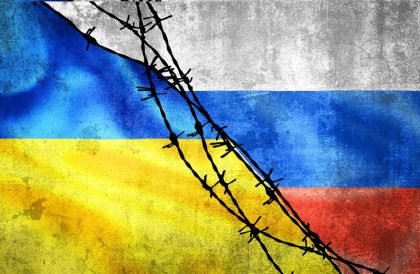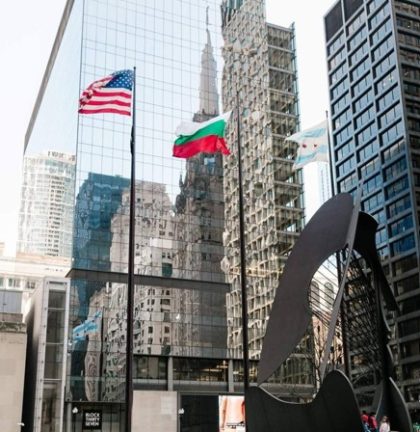
.
A history of the First Bulgarian Empire
.
Steven Runciman
.
Book I THE CHILDREN OF THE HUNS
.
CHAPTER I
The five sons of king Kubrat
Once upon a time, when Constans was Emperor in Byzantium, there lived a king called Kubrat on the shores of the Sea of Azov. In due course he died, leaving five sons behind him, whom he bade live in concord together. But the brothers in a short time quarrelled, as princes often do, and, dividing the inheritance between them, departed each his own way, bearing his portion of the people with him. The eldest brother alone, Baian, remained where he was born; the second brother, Cotrag, crossed the Don, to the northward, and lived on the farther bank; the fourth brother moved far to the westward, and, crossing the Danube, came to Pannonia, where he fell under the domination of the Avars; the youngest wandered even farther, and ended his days in the Pentapolis of Ravenna. But the third brother, whose name was Asperuch, crossed the Dnieper and the Dniester and settled on the banks of the Lower Danube.
There he dwelt with his people, until the Emperor Constantine, displeased at the presence of these barbarians on the very borders of the Empire, determined to stamp them out. The Imperial armies marched to the Danube and invaded the wild country; where Asperuch’s hordes in terror hid for four days in their fastnesses. But the Emperor’s feet were tender and sore; he decided to retire and rest them in his city of Mesembria. The barbarian spies were alert; on his departure the barbarians came out from their strongholds and attacked. The Imperial troops found themselves leaderless; their Emperor had fled, they thought, so they too would flee. Close on their
4
heels came the barbarians, across the Danube, into the province of Moesia. The land pleased Asperuch and his people; they were victorious, and the Emperor could not withstand them. So there they remained, and there their descendants remain, even to this day.
For all its air of a fairy-tale, this story, told by the Greek chroniclers, [1] is in the main a true description of the entry of the Bulgars into Bulgaria. This was not, however, the first time that the Empire had come into contact with Bulgarian tribes. The kingdom of Kubrat, ‘of old called Great Bulgaria’ (though actually its greatness was very newly established), had a past known in part to the historians of Constantinople. We can go back, and, noticing their former raids into civilization, peer into the mists that hang over the Steppes, to see if we can discover who were these Bulgars whose final incoming, in the seventh century, disturbed so lastingly the untranquil Balkans.
The Huns and their tempestuous onrush over Europe made a story that has often been told. But whence they came and whither they went are lost in mystery. Some say they were the Hiung-Nu, the race that was the terror of China; but the Goths, who knew them best, thought otherwise. They told of the wicked sorceresses that King Filimer the Goth banished from his Scythian kingdom, who mingled on their wanderings with the evil spirits of the desert; and from that wild union were born the Huns. [2] Their going is as shrouded as their coming. Not long ago a wave of militarism swept over Europe, and an awful ancestry became the boast of every bellicose nation; Attila was proudly called cousin, if not grandfather, by them all. Of all these claims, it seems that the Bulgars’ is the best justified; the blood of the Scourge of God flows now in
1. Theophanes, pp. 546-9: Nicephorus, pp. 33-5.
2. Jordanes, Getica, p. 89.
5
the valleys of the Balkans, diluted by time and the pastoral Slavs.
At the time of the Huns’ passing, the Empire was still the only civilized State in Europe; and so it is to the Imperial writers that we must go for information. They cannot tell us much; the Steppes were turbulent and very mysterious, and they could not get things clear. They made their attempts at ethnological elucidation, but often it was easier to give them up and seek instead a literary flavour, calling every oncoming tribe the Scythians or Cimmerians. Nevertheless, certain facts emerge. On Attila’s death, his empire crumbled. His people, who had probably been only a conglomeration of kindred tribes that he had welded together, divided again into these tribes; and each went its own way. One of these tribes was soon to be known as the Bulgars.
It was in 482, some thirty years after Attila’s death, that the Bulgars first appear by name. The Emperor Zeno, fighting against the two Theoderics and their Goths, found it necessary to call in to help him the Bulgars, a tribe living apparently to the north-east of the Danube. [1] The incident taught the Bulgars that the Empire could be put to some use; during the next few years they made several successful raids on the Balkans, in 493, 499, and 502. [2] They also entered again into the career of the great Theoderic. In 504 they were allied with the Gepids against him. [3] In 505, when a brigand chief called Mundo (a relative of Attila, but by some said to be Getic and by others Gepid) was attacked at Margum (the junction of the Morava and the Danube) by the ‘Greeks’ (the Imperial
1. John of Antioch, Fragmenta, p. 619.
2. Marcellinus Comes, Chronica Minora, pp. 94, 95, 96. Marcellinus calls them Scythians in 493, but Bulgars in 499, and, in 502, Consueta gens llulgarorum. Theophanes (p. 222), writing several centuries later, mentions only the 502 raid, calling it the first entry of the Bulgars into history.
3. Cassiodorus Senator, p. 160.
6
troops), Theoderic’s general, Pitzia, went to his aid; the Greeks called in Bulgars to fight for them, and the Bulgars there suffered their first defeat. [1]
In 514 the rebel Vitalian employed Bulgars to help him in his attempt against the Emperor Anastasius. [2] In 535 they invaded Mysia; in 538 large numbers of Bulgars, led by two kings, invaded the Balkans and succeeded in defeating and capturing various Imperial generals, including a baptized Hun called Acum. [3] Next year Mundo reappeared into prominence; he was now ruling in Sirmium, and, his old patron Theoderic being dead, he turned for patronage to the Emperor Justinian. He proved a useful vassal, defeating Bulgar raiders so efficiently that no other Hun dared cross the Danube. [4] And so for a while we hear no more of the Bulgars.
Indeed, the Bulgars of whom we have so far heard were a race of no great importance, a wandering, predatory off-shoot of greater nations that lay behind to the east. To these nations the historians of the days of Justinian, when the world was for a while more orderly, direct our notice.
According to Procopius, there once lived a nation of Huns or Cimmerians in the districts to the east of the Sea of Azov and north of the Caucasus. The king of these Huns had two sons, Cuturgur and Uturgur. On his death they divided the people, and Cuturgur went off to conquer new territory. He succeeded at the expense of the Tetraxite Goths of the Taman peninsula, the Crimean
1. Marcellinus Comes, p. 96: Jordanes, Romana, p. 46, Getica, p. 125: Ennodius, pp. 210, an.
2. Malalas, p. 402, calling Vitalian’s allies πλῆϑος Οὔννων καὶ Βουλγάρων: Theophanes, p. 247, using same words: Georgius Hamartolus, ii., p. 619, adds Γότθων.
3. Malalas, p. 437, calling them Huns: Theophanes, p. 338, calling them Bulgars, adding the words καὶ δρούγγου, which have never been satis factorily explained: Anastasius (ii., p. 141) in his paraphrase of Theophanes takes ‘Droggo’ to be the name of a Bulgar king, a partner of Vulger.
4. Theophanes, pp. 339-40.
7
Goths, and other tribes that lived along the northern shore of the Black Sea; and his people made the country their base, from which they raided farther afield. Uturgur, however, stayed in his old home. [1] The eponymous princes probably were born in the simplifying mind of Procopius; but certainly in the sixth century there were two close kindred Hunnish tribes, of the Bulgar branch of the Huns, [2] situated on either side of the Sea of Azov, the Cotrigurs to the west and the Utigurs to the east; and the diplomats at Constantinople found themselves forced to pay them attention.
There were several Hunnish tribes with which the Empire had dealings then existing on the Steppes; there were the Sabirs, whose ruler, a tempestuous widow called Boa, sought the alliance of the Emperor, [3] there were the Ultizurs and the Burugundi, near relatives of the Cotrigurs and Utigurs, whom Agathias mentions merely to tell of their destruction [4]; there were the Saraguri, the Urogi, and the Onoguri, victims of the growth of Sabir power. [5] But, with the possible exception of the Sabirs, the Cotrigurs and the Utigurs alone seem to have enjoyed a formidable power and an efficient organization.
In 528 there was a king of the Crimean Huns called Grod—Theophanes euphonized his name into Gordas, and John of Antioch even more mellifluously into Gordian—who came to Constantinople to be admitted into the Christian Church. His Crimean Huns were probably
1. Procopius, De Bello Gothico, iv., 5, pp. 475 ff. He calls them Cuturguri and Uturguri or Utiguri: Menander and Agathias call them Cotriguri and Utiguri: Theophanes only mentions the Cotragi.
2. None of the sixth-century writers actually call the Cotrigurs or Utigurs Bulgars, but the identification is made certain by later writers. See below, pp. 11, 15.
3. John Malalas, pp. 430-1. Theophanes, p. 269, who calls her Boarex. Sabir alliance was considered useful against the Persians.
4. Agathias, p. 365, talking of Cotrigurs, Utigurs, Ultizurs, and Burugundi, says, ‘οὗτοι δε ἅπαντες κοινῇ μὲν Σκύθαι καὶ Οὖννοι ἐπωνομάζοντο.’
5. Priscus, Fragmenta, p. 341.
8
Procopius’s Cimmerian Huns—that is to say the Cotrigurs, who had settled in the Crimean lands of the Goths, themselves a Christian race. Grod was certainly a personage of some power; his help had already been sought by the Emperor for the Iberians against the Persians. However, the Imperial diplomats overreached themselves; this early evangelization was a failure. When Grod returned home, determined to destroy his people’s idols of silver and electrum, his people objected, and slew him, setting up his brother Mugel in his place. Mugel preferred to remain a heathen. [1]
Meanwhile the Cotrigur power grew. The Tetraxite Goths, crushed by the Cotrigurs, lingered on under Utigur patronage. They were orthodox Christians, and in 548 they sent to Constantinople nominally to ask for a new bishop, but actually to give alarming reports of affairs on the Steppes. [2] Their warnings were justified; in 551 twelve thousand Cotrigurs, under their leader Chinialus, incited by the Gepids, invaded and ravaged the Balkans. The Emperor Justinian, remembering the information of the Tetraxites, hastily sent an embassy and gifts to Sandilch, Khan of the Utigurs, to urge him to attack the Cotrigurs in the rear. Sandilch was delighted to comply with this request, and did his work only too thoroughly. So Justinian, with all the subtlety of Byzantine diplomacy, told the Cotrigurs of the attack on their homes, and gave them money to retire, and even offered to find them homes within his dominions, should they find themselves dispossessed on their return. The Cotrigurs anxiously retreated; and soon afterwards two thousand of them, under a chief called Sinnion, who had once served under Belisarius, came back to the Empire and were settled in
1. John Malalas, pp. 431-2: Theophanes, ad aim. 6oao, pp. 269-70: John of Ephesus, Historia Ecclesiae, p. 475: Procopius, De Bello Persico.
2. Procopius, De Bello Gothico, iv., 4, p. 475.
9
Thrace. Sandilch was annoyed at this volatile policy of the Emperor, and sent a long remonstrance—verbatim through ambassadors, as the Huns could not write. But Justinian ignored the complaints, and merely continued to send the Utigurs a yearly income. [1]
There was a short respite; but the Cotrigurs were incorrigible. In 558, under their king, Zabergan, they came again, in even greater force. Their armies divided into three; one invaded peninsular Greece, one attacked the Thracian Chersonese, and one, the greatest, led by Zabergan himself, forced its way through the Long Walls to the very suburbs of Constantinople. The Emperor was terrified; and the aged Belisarius was summoned to save the Empire. His strategy was successful, and the Cotrigurs were outwitted and routed: while their first army was held up by the defences of Thermopylae, and their second was defeated by the Emperor’s nephew, Germanus, at the entrance to the Chersonese. In the meantime the Emperor sent again to the Utigurs. Fearing lest they should be shy after their first experience of the Imperial alliance, he told them that the Cotrigurs had carried off the money destined that year for them; he could have recovered it himself, but he preferred to test their friendship by leaving it for them to do so. Sandilch was impressed by the argument and wanted the money; and so the Cotrigurs and the Utigurs started gaily on an internecine struggle that kept them fully occupied until a new factor appeared on the scene and brusquely silenced them both. [2]
In the early years of the sixth century a race, known among the powers of the far East as the Zhen-Zhen or the Zhuan-Zhuan, dominated over the inhabitants of Turkestan. As time went on, the Turks tired of this oppression;
1. Procopius, op. cit. iv., 18-19, pp. 550 ff.: Menander Protector, p. 3: Procopius calls the Utigur king, Sandil, Menander and Agathias (see next note), Sandilch. The Tetraxite Goths sent 2,000 men to help the Utigurs.
2. Agathias, p. 367: Theophanes, pp. 360-1.
10
and in the ensuing convulsions the Zhen-Zhen moved off to seek new worlds to conquer in the West. There they received a new name, and as the Avars they played their terrible part in history. [1] The Huns of the Steppes lay right across their path. But nothing could withstand the Avars and Candich, their Khagan. The Utigurs were beaten, the Sabirs utterly destroyed; the Cotrigurs were subjugated, and the Avars passed on, to cause panic-stricken turmoil among the Slavs that were quietly filling the Balkans, and to crush the Antae, the bravest of them all. And so they entered deep into Europe, and spent their days now raiding Germany, now attacking the walls of Constantinople. In 562, Candich was succeeded by Baian, who seems to have organized and ordered the vast Avar Empire, stretching from the Don to the middle Danube. Among their sternly repressed subject-races were the Cotrigurs. [2] Meanwhile the Turks, seeking to emulate their erstwhile masters, also moved westward to conquer. The weary Utigurs were no match for them; in 568 they fell under Turkish dominion—the first time that the Bulgars experienced a taste of their future destiny. [3] Thus, with the Cotrigurs enslaved by the Avars and the Utigurs enslaved by the Turks, the curtain goes down on the first act of Bulgarian history.
When next the curtain rises, the scene is utterly changed. The stage is held by Kubrat, King of Old Great Bulgaria.
Hitherto we have only known the Bulgars as they emerged into the view of Imperial history. It is an inevitable limitation; for the Empire alone was civilized
1. I assume the identification of the Zhuan-Zhuan of the Chinese with the Avars to be generally now accepted. See Marquart, Streifzüge, p. 43.
2. Menander Protector, p. 5.
3. Ibid, pp. 55, 87. Menander’s Uguri and Uiguri must be careless spelling for Utiguri; though, on the other hand, the Hunnish tribes all enjoyed remarkably similar names.
11
enough to produce witnesses capable of writing history, or even of writing at all. But there is one other important testimony, which it is now time to consider; the Bulgars that settled in the present-day Bulgaria produced, in the eighth century, a List of their previous rulers, with dates attached—a work unaffected by any of the historians of the Empire. Unfortunately they gave their dates in their old dead language, so as to provide posterity with an innumerable series of puzzles, philological and mathematical; it is only very recently that new evidence has allowed historians to arrive at any satisfactory conclusions. [1]
Fourth on this List we meet the Khan Kurt, who reigned from 584 to 642. Name and date alike identify him as Kubrat or Crobatus, King of Old Great Bulgaria, King of the Bulgars and their kindred the Cotragi. Of Kubrat’s ancestry the Imperial historians say nothing; but the List tells us that he was of the family of Dulo. Two of his predecessors had belonged to this family, though the third, whom he immediately succeeded, was of the house of Ermi.
The first monarch mentioned was Avitokhol, of the house of Dulo, who reigned for the portentous period of three centuries, from A.D. 146 to 437. His successor, Irnik, did not compete with such tenacity of life; a mere century and a half was all that he could manage (437-582). Next came Gostun, of the Ermi family, with a meagre reign of seventeen months (582-4). And so we come to Kurt, who inherited sufficient longevity from his Dulo ancestors to reign close on sixty years (584-642).
The name Avitokhol seems meaningless: unless we remember that, by the seventh century, Christian, Jewish, and even Moslem missionaries were spreading Old
1. I accept Zlatarski’s dating. See Appendix II.
12
Testament stories all over the Steppes. The Turks improved on the Scriptures, and told of the later history of Japheth, whose eldest son and heir was called Turk, and surnamed Yafeth-Oghlâni (son of Japheth). Yafeth might easily modify itself into Avit, itself a word meaning ‘ancestor.’ Thus, perhaps, Avitokhol, ancestor of the first royal house of Bulgaria, was none other than a grandson of Noah himself. Certainly no member of the Patriarch’s august family would have thought anything of a reign of a mere three hundred years. [1]
Irnik’s parentage was definitely less holy. On the contrary, his father was the Scourge of God. Attila, King of the Huns, left a son whose name was Ernach or Hernak (the Greeks by now dropped their h’s). The Bulgars, we know, were Huns; and Attila died in 453, when, according to the List, Irnik was on the Bulgar throne. That Irnik and Ernach were the same person there can hardly be a doubt. [2] But Ernach lived in Little Scythia—in Bessarabia—and Old Great Bulgaria lay on the shores of the Sea of Azov, stretching to the River Kuphis (Kuban). Ernach’s descendants must, therefore, have some time moved to the east; possibly one of them early assumed control over the Cotrigurs when that tribe migrated westward; but more probably during the dark days of Avar rule it was a prince of the house of Attila—whose family had some time acquired the surname of Dulo and had no doubt kept the headship of one of the many Hunno-Bulgar tribes of the Steppes—that was able to supply the unifying force which rallied all the Huns and
1. Mikkola, Die Chronologie der Türkischen Donaubulgaren, p. 23. He there quotes a Turkish inscription found by Desmaisons at Abulghasi which told of the history of Japheth. Marquart, Die Chronologie der Alttürkischen Inschriften, pp. 75-6, identifies Avitokhol simply with Attila. This is possible, but I think the biblical origin is more convincing; see Appendix III.
2. Zlatarski, Istoriya, i., 1, pp. 40-2, denies the identity of Irnik and Ernach. I give my reasons for disagreeing with him in Appendix III.
13
Bulgars and so built the kingdom of Old Great Bulgaria. This unifier was, I believe, King Kubrat. [1]
The List, then, permits the following deductions. First, from Avitokhol’s three centuries, we may assume that the Bulgar nation had consciously existed for some time past, perhaps even from 146—time enough for it to have acquired a Patriarchal origin: secondly, from Irnik’s century and a half, that the Bulgars of the List belonged to the branch of Attila’s family founded by his son Ernach, and that roughly from 453 till 582 his descendants, known as the house of Dulo (why, we cannot tell), were nonentities overshadowed by the memory of their ancestor: finally, from 582 to 584, the Dulo were replaced by a new but short-lived dynasty, the Ermi and their head, Gostun, till in 584 the Dulo returned in the person of Kubrat or Kurt, the Liberator, who reigned for fifty-eight years.
It was in the days of the Emperor Heraclius that Kubrat’s name was first heard at Constantinople. John, Bishop of Nikiou, writing from the depths of Egypt, told a story of the rumoured alliance between Heraclius’s widow, the Empress Martina, and Kubrat, King of the Huns; and he explained it by mentioning that Heraclius had befriended the Hun at Constantinople in his youth. Kubrat had become a Christian, and then had returned to rule triumphantly in his own country; and he always henceforward regarded the family of Heraclius with grateful affection. Hence it was that when Martina and the Patriarch Pyrrhus plotted to depose her stepson, the Emperor Constantine III, people suspected Kubrat of being an accomplice. [2]
The Ethiopian Bishop was romancing when he pictured
1. John of Nikiou (see below) says that Kubrat made himself supreme over other tribes. Old Great Bulgaria was clearly a composite kingdom of all the Hunno-Bulgars of the Steppes.
2. Chronique de Jean de Nikiou, p. 580.
14
Kubrat being brought up at Constantinople. Heraclius, his kind Emperor, began to reign in 610, when Kubrat had been a king already for twenty-six years. Nevertheless, it seems certain that Kubrat visited Constantinople a little later. In 619, according to the Patriarch Nicephorus, the ruler of the Huns came there with his suite seeking to be baptized. The baptism took place, and the Hunnish monarch returned, having been made a patrician. A few pages later, after speaking of the Avars, Nicephorus tells of Kubrat, ruler of the Unogunduri, who revolted from the Avar Khagan and sent to Heraclius to make an alliance: which was kept throughout his lifetime. Kubrat was also made a patrician. [1] Both Nicephorus and John of Nikiou when they mention Kubrat call him nephew of Organa.
Clearly Nicephorus’s two accounts refer to the same visit. The second indeed is dated in the margin 635, but from its context it certainly may be a digression into the past. And John of Nikiou’s story of Kubrat’s youth at Constantinople is clearly an embroidered improvement on the same visit. Kubrat’s life-history thus fragmentarily emerges.
Kubrat reigned fifty-eight years; he must, therefore, have been a child when his reign began, and as a child he would need a regent. The regent was no doubt his uncle Organa, probably a maternal uncle; otherwise, as an adult member of the house of Dulo, he would certainly have preceded his child nephew on the barbarous throne. [2] Gostun was either a usurper or possibly an Avar-appointed governor, and it was Organa who restored the power of the Dulo. In 619, Kubrat, having taken the government into his own hands, visited Constantinople to secure help
1. Nicephorus, pp. 12 and 24.
2. It seems to me to be quite unnecessary to identify Organa with Gostun. It is unconvincing and nothing is gained by it.
15
against the Avars, against whom he had recently revolted. At this time he was probably just a Hunnish chieftain; his great kingdom was not yet founded. He secured Imperial help—the Emperor was only too grateful for allies against the Avars—at the price of baptism; and on his return he established, not only his independence, but also a supremacy over the neighbouring tribes. When he died, he was ruler of a land lying round the lower Don and south to the Caucasus, the kingdom called Old Great Bulgaria. And he left the five sons of the fairy-story.
It is a little difficult to identify the tribes that made up this kingdom. In his early life, Kubrat is called lord of the Huns or (once by Nicephorus) of the Unogunduri. Theophanes, telling of his sons, calls him lord of Bulgaria and the kindred race the Cotragi (the Cotrigurs), and talks of the Onogunduri, the Bulgars, and the Cotragi as forming his subjects. But the situation of this Bulgaria, from the Don to the Caucasus, is the same as that occupied by the Utigur kingdom. We have heard no more of the Utigurs since their conquest by the Turks. The Turkish tide had ebbed by now, but it must have been strong enough at its fullness utterly to swamp the Utigur power; for it is strange that, while the Cotrigur name survived, the Utigur name vanished. However, considering the geography, it is impossible not to see in the Bulgars of Theophanes the bulk of the old Utigur people, stripped no doubt of its old ruling class, whereas the Cotrigur aristocracy continued an unbroken career. The Onogunduri or Unogunduri present a new difficulty. Before Kubrat’s time we never hear of them, but during the next few years the Imperial writers use their name, the Huns’, and the Bulgars’ indiscriminately to describe the same race. It is possible that the word is a composite affair, a blend of the Huns and the Bulgars, invented by the source from whom Theophanes and Nicephorus both drew, in vague
16
confusion with memories of such early Bulgar tribes as the Onoguri and Burugundi. But all the Hunnish tribes had names of a most unenterprising inter-resemblance, and so it is dangerous to see in any of them an artificial composition. More probably the Onogunduri were the tribe over which the descendants of Ernach ruled. Kubrat in his youth was only lord of the Onogunduri, as Nicephorus says; but he led the revolt against the Avars, and, extending his power eastward over the Cotrigurs and the leaderless Utigurs, founded the new kingdom. The Cotrigurs were probably never completely absorbed. They remained in their old home across the Don, and in the next generation separated again. The second of the five sons in the fairy-story was called Cotragus, and he crossed the Don. Clearly, he owed his name to the nation over which he ruled. [1]
In 642, soon after his rumoured intrigue with the Empress Martina, Kubrat died, at a ripe age and, we may hope, in the odour of sanctity—but we hear no more of his Christianity after his visit to Constantinople; indeed, for two more centuries the Bulgars remained unmistakably heathen. According to the List, his successor was Bezmer, who reigned three years, but after a few months, in February 643, we hear of the accession of Isperikh—we have come here to Asperuch—who reigned fifty-eight years. But, according to the Greek story, the five sons of Kubrat, after living in peace together for a little, presumably under the headship of the eldest, Baian, separated and each went his own way.
1. These problems are fully discussed in Zlatarski (Istoriya, i., I, pp. 84-96). Briefly summarized, his conclusions are (i.) that the house of Dulo has nothing to do with Attila, (ii.) that the Utigurs are the basis of Old Great Bulgaria, and (iii.) that Onogunduri is a composite word—Οὒννοι καὶ Βούλγαροι—and does not describe a separate tribe. For (i.) see my Appendix III. For (ii.) I think his geographical arguments unanswerable, and I am in agreement with the result, with the legitimate modifications suggested above, (iii.) I think unconvincing.
17
It is possible that Baian (or Batbaian, as Theophanes calls him) and Bezmer were the same person. [1] On the other hand, it is rash to identify names merely because it is convenient to do so and they both have the same initial letter; besides, it would really be more convenient to interpose a generation between Kubrat and his sons. Asperuch, the List tells us, reigned fifty-eight years. The similarity of his reign to Kubrat’s is suspicious, though Asperuch’s was a few months longer; but that is not sufficient reason for rejecting it. Certainly both Kubrat and Asperuch enjoyed long reigns. But it seems unlikely that a son should only die one hunded and nineteen years after his father’s accession. Moreover, Asperuch appears to have had younger brothers. Even allowing for the lengthy lives that their excellent sour milk is said to grant the Bulgarians, the matter remains unconvincing. Kubrat’s sons were more probably—some, if not all of them—his grandsons. [2] Their father was Bezmer; but, sandwiched as his paltry reign was between the great Kubrat’s and the great Asperuch’s, his fame never reached Constantinople.
Soon after Bezmer’s accession, the kingdom broke up and the tribes were divided up between various princes of the house of Dulo. The reason was the pressure from a new conquering Turkish race, the Khazars, whose later conversion to Judaism was to be a strange phenomenon in the Christian-Moslem world. At present the Khazars were ruthless militant savages; and Old Great Bulgaria lay in their path. The eldest of the Bulgarian brothers, Baian, stayed at his post; his kingdom, depleted by terrified emigration, fell an easy prey to the Khazars, and he became their tributary. Gradually, it seems, his
1. Zlatarski identifies them, which simplifies his history; but he does not face the difficulty of Kubrat’s and Asperuch’s age.
2. I shall continue to call them, for convenience, the sons of Kubrat.
18
people were mostly absorbed by the conquerors, without much difficulty, for Huns and Turks came both from the common Turanian stock; and the remainder lasted only to be wiped out by the Maygars. Thus Old Great Bulgaria quietly vanished. [1]
The second brother was known to the Greeks as Cotragus, clearly because he ruled the Cotrigurs. Probably he was a viceroy who declared his independence at the collapse of the central power. According to the fairy-story, he crossed the Don and lived on the far side, the northern bank. This crossing would be merely his inevitable journey when he went to govern the Cotrigurs. Later, however, when the Khazar dominion increased, the Cotrigurs moved farther to the north, recrossing the Don during its upper eastward course, and settling by the middle Volga and the Kama. There their descendants remained for many generations to come, known to the world as the Black or White (‘White’ is synonymous with ‘Great’), or even the Silver (an improvement on ‘White’), or merely the Kama Bulgarians. In time they acquired a certain civilization, probably through the Khazars; their capital city, Bulgar, by the junction of the Volga and the Kama, became an important emporium, the centre of the trade of the Volga plain. Early in the tenth century they became converts to Islam, and even imported a Moslem missionary whose gifts included castle-building—indeed he fortified, not only their souls, but their capital—the writer Ibn-Foszlan. Their empire endured till the twelfth century, when they fell before the withering might of the Mongols.
1. Zlatarski, Istoriya, p. 114, says that Batbaian founded the Black Bulgaria (on the River Kuban) of Constantine Porphyrogennetus’s day. But not only Constantine, but also the tenth-century Arab geographers clearly knew only of one Bulgaria on the Steppes, the Kama-Volga Bulgaria, called also, it is true, by such contradictory names as Black and White Bulgaria. See Constantine Porphyrogennetus, De Administrando Imperio, pp. 81, 180: also Maçoudi, Les Prairies d’Or, p. 16; Ibn-Foszlan, De Bulgaris, passim. It seems, however, that till its extinction Old Great Bulgaria was also called White Bulgaria.
19
To the last they remained notorious and efficient raiders. [1]
The third brother was Asperuch, whose fortune, following the pattern of the Greek story-tellers, we shall trace later. The fourth brother crossed the Carpathians and the Danube and came to Pannonia, where the Avar Empire had its main seat. There he became a vassal of the Avars. Probably this migration was due to a desire to combine with the Bulgars that had come with the Avars into the central Danubian plain. That there were Bulgars there is incontestable. Indeed, the Bulgars that accompanied the Avars to the great siege of Constantinople in 626 were almost certainly of this branch; for Kubrat’s Bulgars were at that time intriguing with the Emperor against the Avars. Moreover, in 630 the German historians tell of a strange, tragic episode. In that year, they say, there was war in Pannonia between the Avars and the Bulgars. The latter were beaten, and nine thousand of them, men, women, and children, migrated to Germany and asked King Dagobert to assign them quarters. He bade them go to Bavaria, but told the Bavarians to kill them all. This was almost completely done; only the leader, Alciocus, and seven hundred of them survived, and fled for refuge to the Wendic Mark. [2] Probably this war was a revolt of the Western Bulgars in connection with Kubrat’s successful revolts farther to the east. But, despite Alciocus’s emigration, there were probably many Bulgars remaining in Pannonia; and it was in reinforcement of these that the fourth son of Kubrat came. The Pannonian Bulgars remained under Avar suzerainty till the opening of the ninth century, when we shall hear of them again. [3]
1. See references given in preceding note.
2. Fredegarius Scholasticus, p. 187: Gesta Dagoberti, p. 411, ad aim. 630, gives the same story, leaving out the name Alciocus and allowing no survivors from the Bavarian massacre. Zlatarski (Istoriya, pp. 119-20) says that the name Alciocus was an invention, made in confusion with Alzeco; see p. 21.
3. See p. 50.
20
From the years 675 to 677 the great city of Thessalonica was besieged by a horde of Bulgar tribes, allied with insurgent Slavs of the neighbourhood. Various Bulgar tribes are mentioned by names that occur there and nowhere else; but their leader was a certain Kuber who had recently revolted against his Avar overlords, and crossed the Danube to settle in the Cormesian plain, near the city. As in the previous great sieges by the Slavs, it needed the personal intervention of their patron saint, Demetrius, to save the Thessalonians. [1] The appearance of Kuber and his Bulgars, who had already crossed the Danube by 675, raises certain problems. To solve them, Kuber has been identified as the fourth son of King Kubrat. He went first to Pannonia and there fell under Avar domination; but, disliking it, he revolted and moved south across the Danube and up the Morava, and so to the confines of Thessalonica. [2] It is possible, but it seems improbable, that Kubrat’s fourth son should have been so energetic. On the other hand, the obvious similarity between the names Kubrat and Kuber must not tempt us into a fast identification. But the similarity may not be entirely pointless. Kubrat was still the only great Bulgarian of whom men had hitherto heard. The Thessalonians may well, therefore, have given his name in a debased form to their local Bulgarian; or the martyrologist may simply have made a general muddle of names. But it seems best to attempt no embroidery on the known facts, and to leave Kuber unconnected by relationship or name to King Kubrat. Kuber was merely a stray Bulgarian chieftain, who may have been in the vanguard of Asperuch’s invaders, but more probably, considering the geography of the Balkans, came from Pannonia. He may have been a
1. Sancti Demetrii Martyris Acta, pp. 1364 ff. The date of the siege is approximate; we know it began between the years 670 and 675.
2. Zlatarski, Istoriya, pp. 121-2, 148-51.
21
well-travelled son of Kubrat, or he may have revolted against the Avars with Alciocus, or independently at a later date. Anyhow, after the long, divinely frustrated siege, we hear no more of Kuber. His tribes mingled and were absorbed with their allies, the Slavs, and thus laid the first foundation of the Bulgar claims to Macedonia.
The youngest son went to Ravenna. Here the Greek chroniclers made a small, pardonable mistake. Ravenna, they knew, was a great Italian city, and round it in these troublous times of depopulation many barbarians had settled, Bulgars amongst them [1]; so they used Ravenna for Italy. In truth, the youngest son went farther. In the days of the Lombard King Grimoald (662-671), the Bulgar ‘duke’ Alzeco peaceably invaded Italy and offered himself and his army to be the King’s vassals. Grimoald sent them to Benevento, to his son Romoald, who assigned them three villages near his capital—Sepinum, Bovianum, and Isernia. They settled there, and ‘to this day’—a century later—still partially spoke their old language. [2] There is no reason to doubt that herein we see the fate of the fifth division of Kubrat’s Bulgars—a weak, straggling division by the end of its long journey. The name Alzeco is suspiciously like Alciocus; but that proves nothing. The two chieftains were clearly not the same.
Thus the Bulgar family split up, and spread over Europe, from the Volga to the shadow of Vesuvius. It remains now only to consider the strongest branch of all, the only branch to survive the tempests of the centuries. Asperuch, less restless than his younger brothers, but more enterprising than his elders, moved along the Black Sea coast, across the great rivers of the Steppes, to the land of lagoons and marshes where the Danube joins the sea.
1. Paulus Diaconus, Historia Langobardorum, lib. ii., p. 87.
2. Ibid., op. cit., p. 154.
Sourse: Рromacedonia.org.






